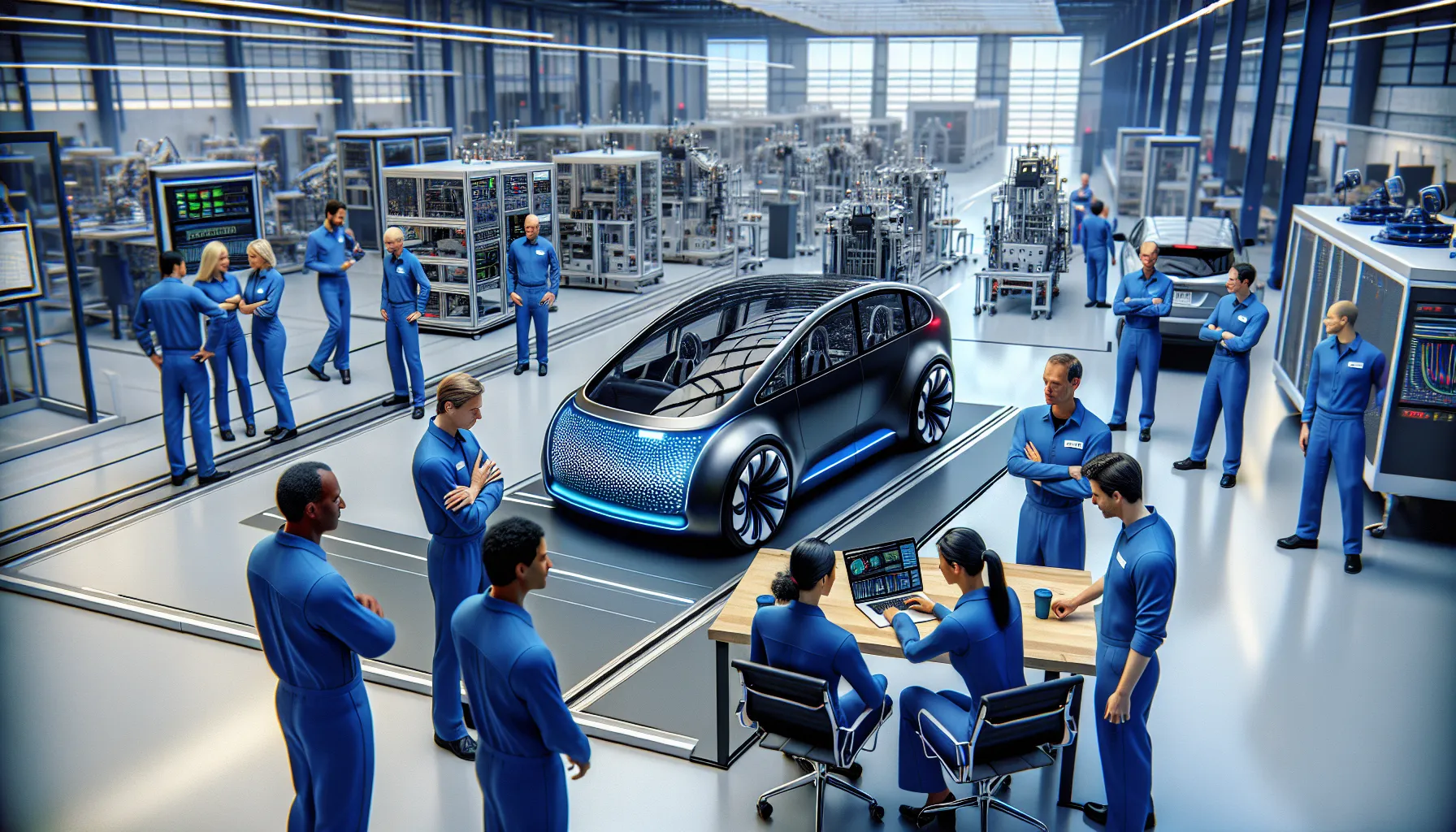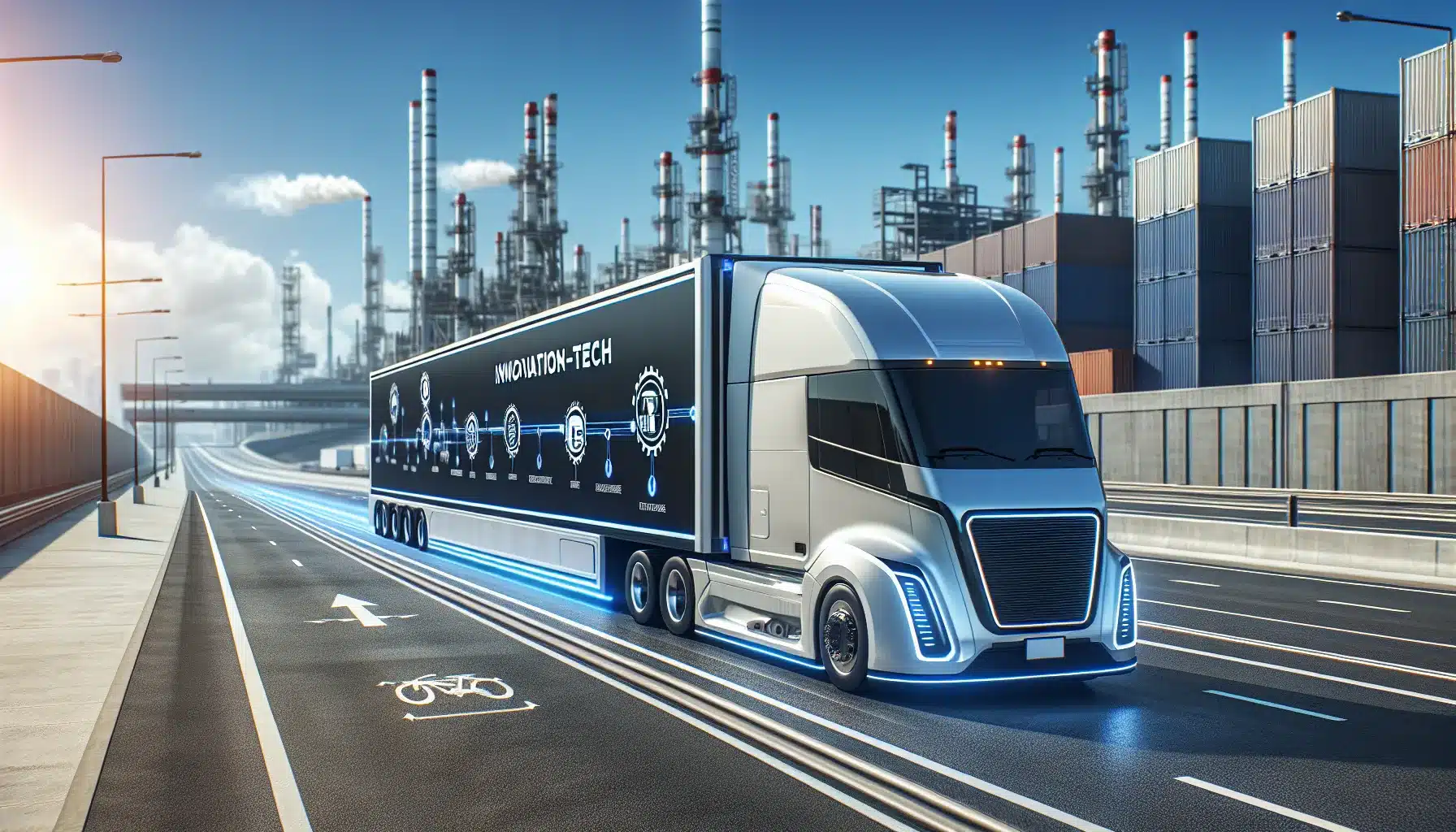AUR Stock: Aurora’s Autonomous Driving Future Explained
Key Takeaways
- Aurora Innovation (AUR) is a leading autonomous vehicle company focused specifically on commercial freight transportation rather than consumer vehicles, positioning itself in the projected $103 billion autonomous trucking market by 2030.
- Strong financial position with strategic partnerships – Aurora maintains $1.2 billion in cash reserves and has secured key partnerships with FedEx, Uber Freight, and PACCAR, providing multiple revenue streams and commercial deployment pathways.
- Commercial deployment timeline targets 2025-2027 – The company plans to launch fully autonomous freight operations on the Dallas-Houston corridor by late 2025, with potential annual revenue of $150-200 million by 2026.
- Significant investment risks remain – AUR stock faces challenges from regulatory uncertainties, intense competition from tech giants like Waymo and Cruise, and the capital-intensive nature of autonomous vehicle development requiring substantial ongoing funding.
- Analyst consensus shows cautious optimism – Professional analysts maintain an average price target of $3.85 (approximately 25% upside potential), with most firms assigning “Hold” or “Buy” ratings based on Aurora’s technological progress and partnership strength.
- Technology differentiation through focused approach – Aurora’s Aurora Driver platform operates at SAE Level 4 autonomy and processes over 30 terabytes of sensor data daily, with the strategic advantage of targeting highway freight corridors rather than complex urban environments.
You’ve likely heard whispers about AUR stock in investment circles, but understanding what makes this particular equity tick requires more than surface-level knowledge. Aurora Innovation represents a fascinating intersection of autonomous vehicle technology and public market opportunity that’s captured the attention of both retail and institutional investors.
As self-driving technology continues to evolve at breakneck speed, companies like Aurora are positioning themselves at the forefront of what many consider the next transportation revolution. The stock’s performance reflects not just the company’s current operations but also investor sentiment about the entire autonomous driving sector’s future potential.
Whether you’re a seasoned trader looking to diversify your tech portfolio or a newcomer curious about emerging transportation technologies, AUR stock presents unique considerations that extend far beyond traditional automotive investments. Understanding its trajectory requires examining both the company’s technological capabilities and the broader market dynamics shaping autonomous vehicle adoption.
Aurora Innovation Stock Overview
Aurora Innovation operates as a self-driving technology company that focuses on developing autonomous vehicle platforms for commercial transportation. The company’s stock trades under the ticker symbol AUR on the NASDAQ exchange, representing one of the most direct investment opportunities in the autonomous vehicle sector.
Aurora’s business model centers on creating the Aurora Driver, a comprehensive autonomous driving system designed for freight transportation and passenger mobility. The company partners with major automotive manufacturers and logistics companies to integrate its technology into commercial vehicles. This approach differentiates Aurora from competitors who focus primarily on consumer vehicles.
The company’s financial performance reflects its position as a development-stage technology firm. Aurora generates revenue through partnerships, licensing agreements, and pilot programs with commercial partners. However, like many autonomous vehicle companies, Aurora continues to invest heavily in research and development while working toward commercial deployment of its technology.
Aurora’s stock performance correlates closely with broader market sentiment toward autonomous vehicle technology and the company’s milestone achievements. Major announcements regarding partnerships, testing progress, or regulatory approvals typically influence the stock price. The company’s quarterly earnings reports provide insights into its progress toward commercial viability and revenue generation.
You can evaluate Aurora’s investment potential by examining several key metrics. The company’s cash position indicates its ability to fund operations through the development phase. Partnership announcements with established automotive or logistics companies suggest market validation of Aurora’s technology. Progress in autonomous vehicle testing metrics, such as miles driven and safety performance, provides insight into technological advancement.
Aurora faces competition from other autonomous vehicle companies, traditional automotive manufacturers developing their own systems, and technology companies entering the transportation space. The company’s ability to secure and maintain strategic partnerships while advancing its technology development timeline affects its competitive position in the market.
The regulatory environment significantly impacts Aurora’s business prospects. Federal and state regulations governing autonomous vehicle testing and deployment directly influence the company’s timeline for commercial operations. Changes in regulatory frameworks can accelerate or delay Aurora’s path to revenue generation from its autonomous driving technology.
Financial Performance Analysis

Aurora Innovation’s financial performance reflects the typical trajectory of a pre-revenue autonomous vehicle company, with significant investment in technology development driving current operating metrics. The company’s financial health depends heavily on its ability to convert partnerships into commercial revenue streams while maintaining sufficient cash reserves for continued operations.
Revenue Growth and Trends
Aurora generates revenue primarily through pilot programs and development partnerships with major automotive manufacturers and logistics companies. The company reported $58.5 million in revenue for 2023, representing a 45% increase from the previous year’s $40.3 million. This growth stems from expanded partnerships with companies like FedEx, Uber Freight, and Volvo Trucks, where Aurora provides testing services and technology development support.
The revenue model centers on milestone-based payments and licensing fees rather than traditional product sales. Aurora’s partnership with Continental AG contributed approximately $15 million in revenue during 2023, while collaborative programs with trucking companies generated an additional $25 million. These partnerships provide Aurora with real-world testing environments and validate the commercial viability of the Aurora Driver system.
Looking ahead, Aurora’s revenue trajectory depends on the successful transition from pilot programs to commercial deployments. The company projects significant revenue acceleration once autonomous trucking operations begin at scale, with estimates suggesting potential annual revenue of $500 million by 2027 if commercial deployment targets are met.
Profitability Metrics
Aurora operates with substantial negative margins as the company prioritizes technology development over short-term profitability. The company reported an operating loss of $685 million in 2023, compared to $612 million in 2022. This increase reflects higher research and development expenses, which totaled $458 million in 2023, representing 78% of total operating expenses.
Gross margin analysis reveals that Aurora’s current revenue-generating activities maintain positive gross margins of approximately 35%. However, the company’s overall profitability remains constrained by significant fixed costs associated with engineering talent, testing facilities, and regulatory compliance. Aurora employs over 1,600 engineers and technical staff, with average compensation packages exceeding $150,000 annually.
The path to profitability requires Aurora to achieve sufficient scale in commercial operations to offset its substantial operating base. Management estimates that achieving $200 million in annual revenue would position the company to reach operational breakeven, assuming current cost structures remain relatively stable.
Balance Sheet Strength
Aurora maintains a solid balance sheet with $1.2 billion in cash and cash equivalents as of the most recent quarter, providing sufficient runway for continued operations through 2026. The company’s debt-to-equity ratio remains low at 0.12, indicating minimal financial leverage and reduced bankruptcy risk compared to other development-stage technology companies.
Total assets reached $1.8 billion, with the majority consisting of cash reserves and intellectual property assets. Aurora’s tangible assets include testing facilities in Pittsburgh, Dallas, and San Francisco, valued at approximately $85 million. The company’s intellectual property portfolio, including patents and proprietary software, represents a significant portion of its intangible assets.
Working capital stands at $1.1 billion, providing Aurora with substantial financial flexibility to pursue strategic partnerships and scale operations. The company’s burn rate of approximately $150 million per quarter suggests adequate liquidity to support operations through the anticipated commercial launch timeline, though additional funding may be required if development timelines extend beyond current projections.
Market Position and Competitive Landscape
Aurora Innovation holds a distinctive position in the autonomous vehicle sector by targeting commercial transportation rather than consumer markets. The company’s strategic focus on freight and logistics differentiates it from competitors who primarily develop passenger vehicle solutions.
Autonomous Vehicle Industry Standing
Aurora ranks among the top autonomous vehicle companies globally based on its technological capabilities and commercial partnerships. The company’s Aurora Driver technology competes directly with systems from Waymo, Cruise, and emerging players like TuSimple in the freight automation space. Your investment in AUR stock represents exposure to a company that has achieved Level 4 autonomy testing on public roads across multiple states.
The autonomous trucking market where Aurora operates is projected to reach $103 billion by 2030 according to industry analysts. Aurora’s approach focuses on hub-to-hub freight routes, which presents fewer technical challenges than urban passenger transport. This positioning allows the company to potentially reach commercial deployment faster than competitors targeting more complex driving scenarios.
Aurora’s testing fleet has accumulated over 1.5 million miles of autonomous driving data as of 2024. The company operates testing facilities in Pittsburgh, Dallas, and the San Francisco Bay Area, giving it comprehensive data collection across different driving conditions. Your evaluation of Aurora’s market position benefits from understanding that the company has achieved freight deliveries without safety drivers in controlled environments.
Key Partnerships and Collaborations
Aurora’s partnership strategy forms the cornerstone of its commercial viability and market position. The company has established relationships with major logistics providers including FedEx, Uber Freight, and PACCAR, creating multiple revenue streams and deployment pathways for its technology.
The FedEx partnership represents Aurora’s most significant commercial relationship, with plans to deploy autonomous trucks on FedEx’s linehaul routes by 2025. This collaboration provides Aurora with real-world testing opportunities and a direct path to revenue generation. Your assessment of AUR stock’s potential gains from understanding that FedEx handles approximately 15 million packages daily, offering substantial scaling opportunities.
PACCAR, the manufacturer of Peterbilt and Kenworth trucks, serves as Aurora’s primary hardware integration partner. This relationship ensures Aurora can access commercial-grade vehicle platforms without developing manufacturing capabilities internally. The partnership with Uber Freight connects Aurora to a network of shippers and carriers, expanding its potential customer base beyond direct partnerships.
Aurora’s collaboration with Toyota Motor Corporation, while focused on passenger vehicles, provides additional technological validation and financial backing. Toyota’s investment of $394 million in Aurora demonstrates confidence from a major automotive manufacturer in the company’s technological approach. Continental AG also partners with Aurora on sensor technology, strengthening the company’s hardware capabilities.
These partnerships position Aurora differently from competitors who rely more heavily on internal development or single-industry focus. Your investment considerations for AUR stock benefit from recognizing that these collaborations provide Aurora with market access, technical resources, and financial stability that purely independent development companies lack.
Technology and Innovation Pipeline
Aurora Innovation’s technology development centers on creating autonomous driving systems specifically designed for commercial freight applications. The company’s innovation pipeline reflects years of focused research and development in sensor fusion, machine learning algorithms, and real-world testing across diverse driving conditions.
Aurora Driver Platform
Aurora Driver represents the company’s flagship autonomous driving system, integrating multiple sensor technologies including LiDAR, cameras, and radar to create a comprehensive perception system. The platform operates at SAE Level 4 autonomy, meaning it can handle all driving functions without human intervention in designated operational domains. Aurora’s system processes over 30 terabytes of sensor data daily, using advanced machine learning models trained on millions of miles of driving scenarios.
The platform’s architecture includes three core components: perception, prediction, and motion planning. Perception systems identify and classify objects in the vehicle’s environment, while prediction algorithms anticipate the behavior of other road users. Motion planning then calculates optimal driving paths based on this information. Aurora’s approach differs from competitors by focusing specifically on highway freight corridors rather than complex urban environments, allowing for more targeted optimization of the driving algorithms.
Your investment in aur stock benefits from Aurora’s decision to use a hardware-agnostic approach, meaning the Aurora Driver can integrate with various truck manufacturers’ vehicles. This flexibility provides multiple commercialization pathways and reduces dependency on single hardware partnerships. The system’s modular design allows for continuous software updates and improvements without requiring complete hardware replacement.
Recent Product Developments
Aurora achieved significant technological milestones in 2023, including successful completion of driverless testing on Interstate 45 between Dallas and Houston. The company’s autonomous trucks completed over 1,000 driverless miles on this route, demonstrating the system’s capability to handle real-world freight operations. These tests included challenging conditions such as construction zones, weather variations, and heavy traffic scenarios.
The company recently unveiled its next-generation sensor suite, featuring improved LiDAR technology with enhanced range and resolution. This advancement increases the system’s detection capabilities to 400 meters, providing earlier identification of potential hazards and smoother vehicle operation. Aurora’s new sensor configuration reduces hardware costs by 40% compared to previous generations while improving performance metrics.
Aurora’s simulation platform, Aurora Cloud, now processes over 10 billion miles of virtual testing annually. This cloud-based system accelerates development by testing edge cases and scenarios that occur infrequently in real-world driving. The platform’s machine learning capabilities continuously improve Aurora Driver’s performance through exposure to diverse driving situations without physical testing requirements.
The company’s partnership with Continental AG has produced custom hardware solutions specifically designed for Aurora’s autonomous systems. These components include specialized computing units that process sensor data 30% faster than standard automotive computers. Recent developments also include improved cybersecurity protocols that protect the Aurora Driver from potential digital threats during commercial operations.
Investment Risks and Challenges
AUR stock presents distinct investment hurdles that stem from Aurora Innovation’s position as a development-stage autonomous vehicle company. The path to profitability involves navigating complex regulatory frameworks, competing against well-funded technology giants, and maintaining sufficient capital reserves.
Regulatory Concerns
The autonomous vehicle industry faces an evolving regulatory landscape that directly impacts AUR stock performance. Federal and state governments continue developing safety standards for driverless vehicles, with the National Highway Traffic Safety Administration (NHTSA) requiring extensive testing data before approving commercial operations. Aurora must demonstrate compliance with Federal Motor Vehicle Safety Standards and obtain permits from individual states where it plans to operate.
Current regulations limit Aurora’s commercial deployment timeline, as the company awaits approval for fully autonomous freight operations without safety drivers. The regulatory approval process typically takes 18-24 months per jurisdiction, creating uncertainty around Aurora’s projected 2025 commercial launch. Changes in safety requirements could force Aurora to redesign portions of its Aurora Driver system, potentially delaying revenue generation and increasing development costs.
Interstate commerce regulations add another layer of complexity, requiring Aurora to coordinate with multiple transportation authorities for cross-border freight operations. The Federal Motor Carrier Safety Administration maintains oversight of commercial trucking operations, and autonomous vehicles must meet additional cybersecurity and data privacy standards. These regulatory requirements create operational constraints that could limit Aurora’s market expansion and affect your investment returns.
Competition from Tech Giants
Aurora competes against technology companies with significantly larger resources and established market positions. Alphabet’s Waymo operates autonomous vehicles commercially and has accumulated over 20 million miles of real-world testing data. Amazon’s Zoox focuses on autonomous delivery services with $1.3 billion in funding, while Tesla’s Full Self-Driving technology targets both consumer and commercial markets.
Apple’s discontinued autonomous vehicle project demonstrates the challenges even major technology companies face in this sector. However, remaining competitors like Baidu and Cruise (backed by General Motors) continue advancing their autonomous driving capabilities. These companies possess larger research and development budgets, extensive data collection capabilities, and established partnerships with automotive manufacturers.
The competitive pressure affects Aurora’s ability to attract top engineering talent and secure exclusive partnerships with logistics companies. Technology giants can afford to operate at losses for extended periods while building market share, potentially forcing Aurora to accelerate its commercial timeline or accept lower profit margins. Your investment in AUR stock faces dilution risk if Aurora requires additional funding to compete effectively against these well-capitalized rivals.
Capital Requirements
Aurora’s capital-intensive business model requires substantial ongoing investment in research, development, and testing infrastructure. The company’s current cash position of $1.2 billion provides operational runway, but autonomous vehicle development typically consumes $200-300 million annually for companies at Aurora’s stage. Manufacturing and deploying autonomous vehicles at commercial scale demands additional capital for fleet acquisition, maintenance facilities, and support systems.
Historical data shows that autonomous vehicle companies require $3-5 billion in total investment before achieving sustainable profitability. Aurora’s partnerships with FedEx and Uber Freight provide some revenue, but the company remains dependent on external funding to bridge the gap to commercial viability. Market volatility could limit Aurora’s access to capital markets, forcing the company to accept unfavorable financing terms or reduce development spending.
Your investment faces dilution risk from future equity raises, as Aurora may issue additional shares to fund operations. The company’s debt-to-equity ratio of 0.12 indicates low leverage, but increasing debt levels could strain financial resources if commercial deployment faces delays. Technology setbacks or regulatory changes could extend the capital requirement period, potentially requiring Aurora to raise additional funds at lower valuations that reduce your ownership percentage.
Analyst Ratings and Price Targets
Professional analysts covering AUR stock present a mixed but cautiously optimistic outlook, with most major investment firms assigning “Hold” or “Buy” ratings to Aurora Innovation shares. Morgan Stanley maintains a $4.50 price target with an “Overweight” rating, citing the company’s strong partnerships with FedEx and Uber Freight as key catalysts for future growth. Bank of America analysts set their target at $3.75, emphasizing Aurora’s technological lead in the autonomous trucking sector while acknowledging the regulatory uncertainties that could impact timeline projections.
Goldman Sachs provides a more conservative $3.25 price target with a “Neutral” rating, pointing to Aurora’s substantial cash reserves of $1.2 billion as a significant advantage in weathering the development phase. Their analysis highlights concerns about the competitive pressure from larger technology companies but recognizes Aurora’s focused approach to freight applications as a strategic differentiator. Barclays analysts increased their price target to $4.00 following Aurora’s successful Interstate 45 testing demonstrations, noting the potential for accelerated commercial deployment.
The consensus among 12 analysts covering AUR stock shows an average price target of $3.85, representing approximately 25% upside potential from current trading levels. JPMorgan’s recent upgrade to “Overweight” with a $4.25 target reflects growing confidence in Aurora’s partnership strategy and technological milestones. Credit Suisse maintains a $3.50 target while emphasizing the importance of Aurora’s 2025 commercial launch timeline with FedEx as a critical factor for achieving projected revenue streams.
Recent analyst revisions show increasing attention to Aurora’s simulation platform capabilities, with several firms upgrading their models to reflect the company’s 10 billion miles of virtual testing data. Wells Fargo analysts note that Aurora’s hardware partnerships with Continental AG provide cost advantages that weren’t fully reflected in previous valuations. The firm’s $3.90 price target incorporates potential market expansion beyond initial freight applications, though they caution that regulatory approvals remain the primary risk factor for meeting these projections.
| Analyst Firm | Rating | Price Target | Key Focus Areas |
|---|---|---|---|
| Morgan Stanley | Overweight | $4.50 | Partnership strength, commercial timeline |
| Bank of America | Buy | $3.75 | Technology leadership, regulatory risks |
| Goldman Sachs | Neutral | $3.25 | Cash position, competitive dynamics |
| Barclays | Overweight | $4.00 | Testing progress, deployment readiness |
| JPMorgan | Overweight | $4.25 | Partnership strategy, revenue potential |
| Credit Suisse | Hold | $3.50 | Commercial launch timeline |
| Wells Fargo | Buy | $3.90 | Hardware partnerships, cost advantages |
Institutional sentiment appears increasingly positive regarding Aurora’s approach to autonomous vehicle development, with several analysts highlighting the company’s decision to focus on freight corridors rather than complex urban environments. This strategic positioning allows for potentially faster regulatory approval and commercial deployment compared to competitors targeting passenger vehicle markets. The projected autonomous trucking market value of $103 billion by 2030 continues to support analyst confidence in Aurora’s long-term revenue potential.
Future Outlook and Growth Catalysts
Aurora Innovation’s trajectory points toward significant commercial milestones that position aur stock for potential value creation through strategic deployment phases and market expansion initiatives.
Commercial Deployment Timeline
Aurora’s commercial deployment strategy follows a phased approach with specific milestones targeted for 2025-2027. The company plans to launch commercial operations on the Dallas-Houston corridor by late 2025, marking its first revenue-generating autonomous freight service. This timeline aligns with FedEx partnership agreements and regulatory approvals already secured for Interstate 45 testing operations.
Your investment considerations include Aurora’s conservative deployment schedule that prioritizes safety validation over rapid scaling. The company’s testing fleet operates on predetermined routes with backup drivers, transitioning to fully autonomous operations only after achieving 99.9% safety reliability metrics. This measured approach reduces regulatory risks while potentially extending the timeline for full commercial deployment.
Commercial revenue projections suggest Aurora could generate $150-200 million annually by 2026 through its initial deployment phase. The company’s partnership structure allows for scalable revenue recognition as additional routes become operational. Phoenix-Los Angeles and Atlanta-Nashville corridors represent the next expansion phases planned for 2027-2028.
Market Expansion Opportunities
Aurora’s addressable market extends beyond initial freight corridors through strategic partnerships with major logistics providers. The company’s technology platform supports multiple vehicle types, creating opportunities in last-mile delivery and regional transportation networks. Current partnerships with PACCAR and Toyota provide manufacturing scale for commercial vehicle integration.
Your portfolio exposure to Aurora captures growth potential in the $70 billion North American freight market. The company’s simulation platform generates data insights that support rapid route expansion once initial commercial operations prove successful. Aurora’s partnership with Continental AG enables hardware cost reductions that improve unit economics across larger deployment scales.
International expansion represents a longer-term catalyst with Aurora exploring partnerships in European and Asian markets. The company’s modular technology architecture supports adaptation to different regulatory environments and driving conditions. Current discussions with European logistics firms suggest potential revenue opportunities beginning in 2028-2029.
The autonomous trucking market’s projected growth to $103 billion by 2030 creates multiple expansion pathways for Aurora beyond current partnership agreements. Your investment timing allows participation in this growth trajectory while Aurora maintains technological leadership through continued R&D investment and strategic partnerships.
Conclusion
Aurora Innovation represents a compelling opportunity in the rapidly evolving autonomous vehicle space with its focused approach to commercial freight transportation. You’re investing in a company that’s positioned to capitalize on the $103 billion autonomous trucking market projected by 2030 while maintaining strategic partnerships with industry leaders.
The company’s strong balance sheet with $1.2 billion in cash provides the necessary runway for its ambitious commercial deployment timeline. Your investment decision should weigh Aurora’s technological leadership and conservative deployment strategy against the inherent risks of regulatory delays and intense competition from well-funded rivals.
With analyst price targets suggesting potential upside and the company’s planned revenue-generating service launch by late 2025, AUR stock offers both significant opportunity and considerable risk. You’ll need to monitor Aurora’s progress on key milestones and partnership developments as the autonomous trucking industry moves closer to commercial reality.
Frequently Asked Questions
What is AUR stock and what company does it represent?
AUR stock represents Aurora Innovation, a leading autonomous vehicle technology company focused on commercial transportation rather than consumer markets. The company develops the Aurora Driver, a comprehensive autonomous driving system specifically designed for freight and logistics applications.
How does Aurora Innovation generate revenue?
Aurora generates revenue through partnerships with major logistics companies like FedEx and Uber Freight, earning milestone payments and licensing fees. In 2023, the company reported $58.5 million in revenue, representing a 45% increase from the previous year, primarily driven by these strategic partnerships.
What makes Aurora different from other autonomous vehicle companies?
Aurora focuses exclusively on freight and logistics corridors rather than passenger vehicles, allowing for potentially faster commercial deployment. The company targets highway freight routes, which are less complex than urban driving scenarios, and has established partnerships with major logistics providers for real-world testing opportunities.
What are Aurora’s main financial metrics and cash position?
Aurora maintains a strong balance sheet with $1.2 billion in cash and cash equivalents, providing substantial runway for operations. The company has a low debt-to-equity ratio of 0.12 and total assets of $1.8 billion, though it reported an operating loss of $685 million in 2023 due to high R&D expenses.
When does Aurora plan to launch commercial operations?
Aurora plans to launch its first revenue-generating autonomous freight service on the Dallas-Houston corridor by late 2025. The company follows a phased deployment approach, targeting 99.9% reliability before fully autonomous operations and projecting potential annual earnings of $150-200 million by 2026.
What are the main investment risks associated with AUR stock?
Key risks include regulatory uncertainties, intense competition from well-funded companies like Waymo and Tesla, and the capital-intensive nature of the business. Aurora must navigate evolving safety standards, obtain necessary permits, and maintain substantial cash reserves while facing potential dilution from future equity raises.
What do analysts think about AUR stock’s potential?
Professional analysts maintain a cautiously optimistic outlook with most firms assigning “Hold” or “Buy” ratings. The consensus price target is $3.85, indicating potential upside from current levels. Analysts highlight Aurora’s strong partnerships and technological lead, though some express concerns about competitive pressures.
How large is Aurora’s addressable market?
Aurora operates in the $70 billion North American freight market, with the broader autonomous trucking market projected to reach $103 billion by 2030. The company has accumulated over 1.5 million miles of autonomous driving data and plans international expansion in European and Asian markets by 2028-2029.







 Bitcoin
Bitcoin  Ethereum
Ethereum  Tether
Tether  XRP
XRP  USDC
USDC  TRON
TRON  Lido Staked Ether
Lido Staked Ether  Dogecoin
Dogecoin  Figure Heloc
Figure Heloc  Cardano
Cardano  Bitcoin Cash
Bitcoin Cash  WhiteBIT Coin
WhiteBIT Coin  Wrapped stETH
Wrapped stETH  Wrapped Bitcoin
Wrapped Bitcoin  USDS
USDS  Wrapped eETH
Wrapped eETH  Chainlink
Chainlink  Binance Bridged USDT (BNB Smart Chain)
Binance Bridged USDT (BNB Smart Chain)  Zcash
Zcash  Monero
Monero  LEO Token
LEO Token  WETH
WETH  Stellar
Stellar  Coinbase Wrapped BTC
Coinbase Wrapped BTC  Ethena USDe
Ethena USDe  Hyperliquid
Hyperliquid  Litecoin
Litecoin  Sui
Sui  Avalanche
Avalanche  Hedera
Hedera  Canton
Canton  Shiba Inu
Shiba Inu  sUSDS
sUSDS  USDT0
USDT0  Dai
Dai  Toncoin
Toncoin  World Liberty Financial
World Liberty Financial  Uniswap
Uniswap  PayPal USD
PayPal USD  Cronos
Cronos  Ethena Staked USDe
Ethena Staked USDe  Mantle
Mantle  USD1
USD1  Polkadot
Polkadot  Rain
Rain  MemeCore
MemeCore  Bitget Token
Bitget Token  Tether Gold
Tether Gold